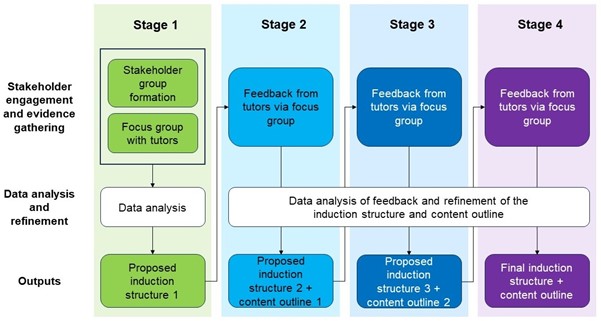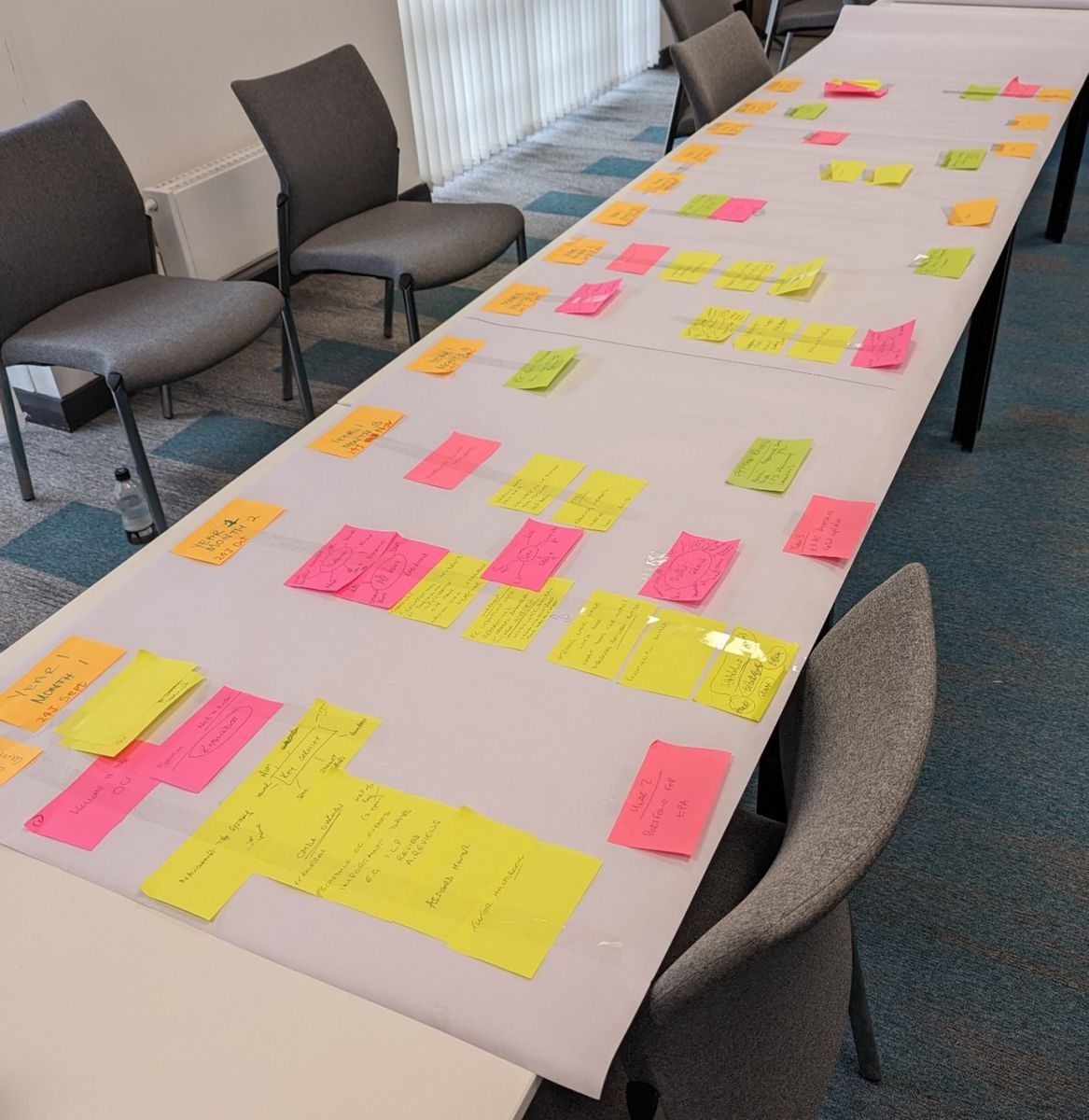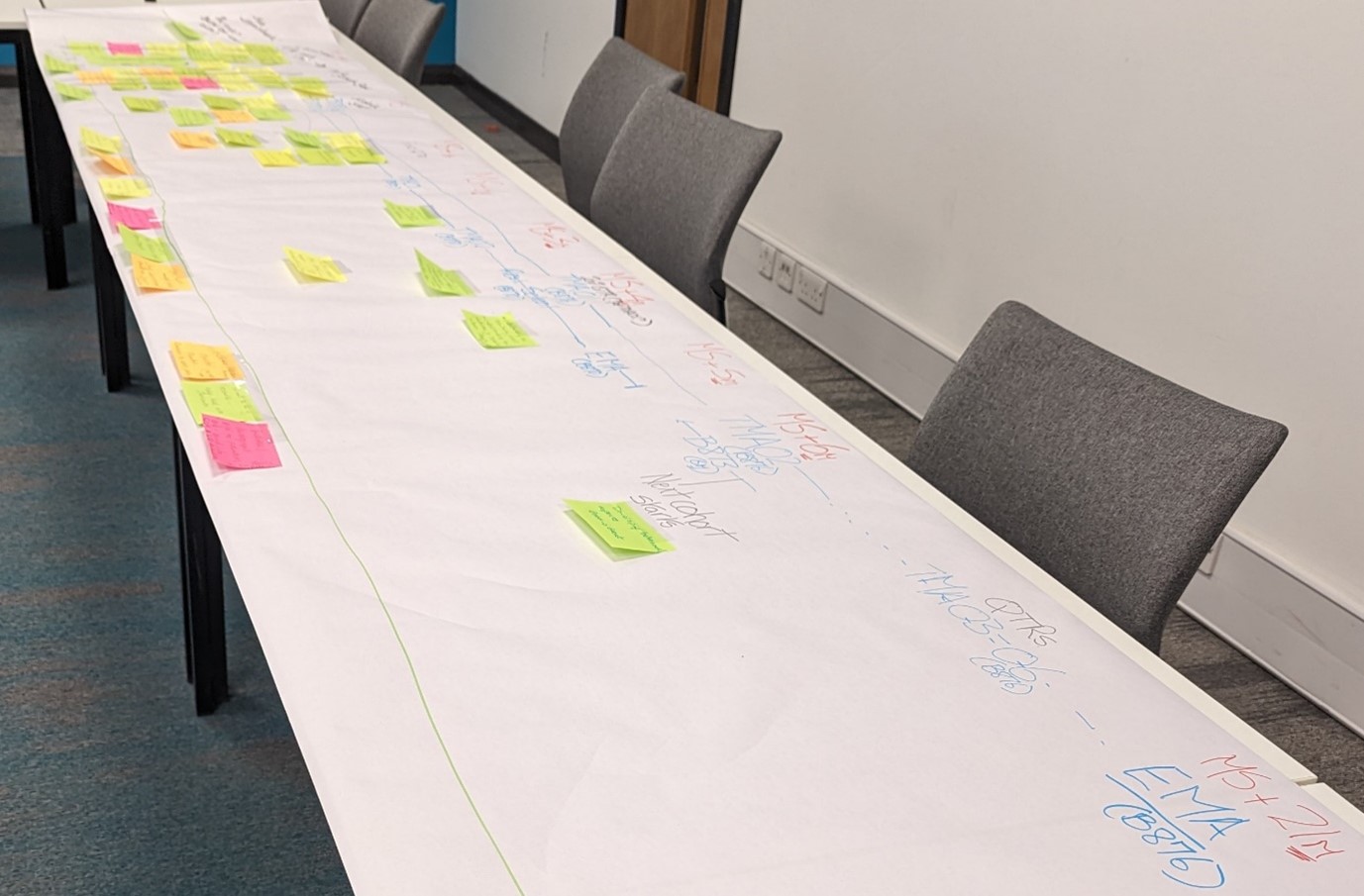Redesigning the Practice Tutor Induction using a co-design approach (part 2)

Introduction
When researching what tutors and their line managers wanted in an induction (Understanding what practice tutors in the Faculty of Business and Law need and want in their induction), the study recommended redesigning the induction using a co-design approach.
A co-design approach is person-centred and looks for practical and real-world solutions to an end goal without concentrating on what is wrong (Bate and Robert, 2007; Lenihan and Briggs, 2011). It draws on many different perspectives, people, experts, and disciplines, that allow the generation of ideas from many other experiences. A distinguishing feature of co-design is the underpinning philosophy based on participatory design (Blomkamp, 2018).
This process values the professional nature and the experiences of the stakeholders involved, with the initial design recommendations fitting the needs of the employees and employers (Steen et al., 2011). This has been proven more conducive to impact in relation to practitioners than expected when adopting a more traditional academic-designed project.
The project
This project was funded through SCiLAB scholarship seedcorn funding and aimed to develop the Practice Tutor (PT) induction for two different management programmes within the Faculty of Business and Law (FBL), the Senior Leader (SLA) and Chartered Manager (CMDA) apprenticeship programmes. Although these programmes are similar, there are distinct differences in structure and processes. One of the aims of the project was to compare the two.
The process
The co-design process used is similar to that employed by Jackman et al. (2021) to develop inductions for doctoral researchers to support their mental health and well-being. All data was gathered via four focus groups, one face-to-face and three online. The process used is depicted in Figure 1 below.

Figure 1:Overview of stages in the co-design process used
Initial focus group (stage 1)
Several PTs were recruited as the primary stakeholder group from the CMDA and SLA programmes. A face-to-face session was arranged for all tutors to meet and get to know each other. They spent the day discussing what activities and tasks were part of their role with apprentices in their programme groups before constructing a timeline of training and CPD activities, sharing what each programme had created, and highlighting areas to each group they had not considered. Following this, each group constructed a timeline showing when each training or CPD activity was required to ensure the tutors could support the apprentices to a good standard. When asked for feedback on the session, the PTs found it valuable “to build rapport with the group,” which also allowed “more productive outcomes” compared to only doing this online.
During these discussions, we took notes and asked questions to clarify any points on from the tutors’ perspectives. The timelines indicated when the various activities and associated training should take place and Figures 2 and 3 show the development of the timelines.
The diagrams and any notes were analysed, and an initial structure to the induction was created for each programme and shared with the tutors ahead of the following focus group so they could consider and prepare their comments.

Figure 2: CMDA Timeline

Figure 3: SLA Timeline
The diagrams and any notes were analysed, and an initial structure to the induction was created for each programme and shared with the tutors ahead of the following focus group for them to consider and prepare comments on.
Iterative focus group sessions (stages 2 – 4)
After the face-to-face focus group, there were three online focus groups with the same tutors. After the initial session, this was their opportunity to review and comment on the proposed induction structure. The first online focus groups highlighted that indicative content for each training and CPD activity would help understand what each session could entail. This led to discussions on what the indicative content could be, including some suggested changes to the timeline. This data was analysed to refine the proposed induction structure and create an indicative content document highlighting the main areas covered in each training and CPD activity.
Before each subsequent online focus group, the tutors were sent the updated proposals. More feedback and suggestions were gathered, and the proposed structure and indicative content were refined until after Stage 4 when a final induction structure and indicative content were agreed upon.
Within stages 2 – 4, the proposed structure and indicative content were shared with the Student Experience Managers (SEMs) at a team meeting to comment on as line managers. The final indicative content was also shared with the Associate Lecturer Support and Professional Development (ALSPD) team to identify which areas of the structure are core to all PTs in the Open University and work collaboratively with them in developing and updating the core training materials.
Conclusion
This process was invaluable in bringing a group of stakeholders together to work collegially and examine and address improvements. This allowed PTs more significant input onto a programme that would be of great benefit to them and new staff. The timelines and indicative content documents are being used to author induction and training Virtual Learning Environment (VLE) page for new PTs, but this will also be a reference area for existing PTs in the Faculty of Business and Law on the leadership and management apprenticeship programmes, with plans to expand and include policing programmes.
References
- Bate, S. and Robert, G. (2007) Bringing user experience to health care improvement: the concepts, methods and practices of experience-based design. CRC Press.
- Blomkamp, E. (2018). The Promise of Co-Design for Public Policy. Australian Journal of Public Administration, 77(4), 729–743. https://doi.org/10.1111/1467-8500.12310
- Jackman, P. C., Sanderson, R., & Jacobs, L. (2021). Developing inductions to support mental health and well-being in doctoral researchers: Findings from a qualitative co-design study with doctoral researchers and university stakeholders. European Journal of Higher Education, 13(1), 62–79. https://doi.org/10.1080/21568235.2021.1992293
- Lenihan D. and Briggs, L. (2011) Co-Design: Towards a New Service Vision for Australia, Public Administration Today, January-February, pp. 35-47 available at: http://canada2020.ca/wp-content/uploads/2015/05/co-design-new-service-vision.pdf
- Steen, M., Manschot, M., & de Koning, N. (2011). Benefits of Co-design in Service Design Projects. International Journal of Design, 5(2), 53–60.
Biography
 Angelique Johnstone currently works as the Lead Student Experience Manager and Qualification Lead for the Senior Leader Apprenticeship programmes. Awarded Senior Fellowship of Advanced HE and Chartered Manager status with the Chartered Management Institute (CMI). Currently she works with approximately 25 Practice Tutors (PTs) to support the apprentices and ensures that they have the best student experience possible on the programme and with The Open University. Her background is in Finance, Leadership and Management and Project Management. She has been working within work-based learning and apprenticeships for over 15 years which has led to using her experience in contributing towards developing learning materials and in leading the PTs. Recently she has completed her Masters in Education (Educational Leadership) and her scholarship interests lie in the induction and development of tutors supporting apprenticeships and work-based learning.
Angelique Johnstone currently works as the Lead Student Experience Manager and Qualification Lead for the Senior Leader Apprenticeship programmes. Awarded Senior Fellowship of Advanced HE and Chartered Manager status with the Chartered Management Institute (CMI). Currently she works with approximately 25 Practice Tutors (PTs) to support the apprentices and ensures that they have the best student experience possible on the programme and with The Open University. Her background is in Finance, Leadership and Management and Project Management. She has been working within work-based learning and apprenticeships for over 15 years which has led to using her experience in contributing towards developing learning materials and in leading the PTs. Recently she has completed her Masters in Education (Educational Leadership) and her scholarship interests lie in the induction and development of tutors supporting apprenticeships and work-based learning.

Blog posts
- Rethinking Tuition: Reflections from the Staff Tutor / Student Experience Manager (SEM) Symposium, 4-5 December 2024 6th June 2025
- ‘Hitting the keyboard’ : Exploring student feelings and approaches to developing legal research skills 9th May 2025
- From Feedback to Action: The Student Voice Festival in Law Education 15th April 2025
